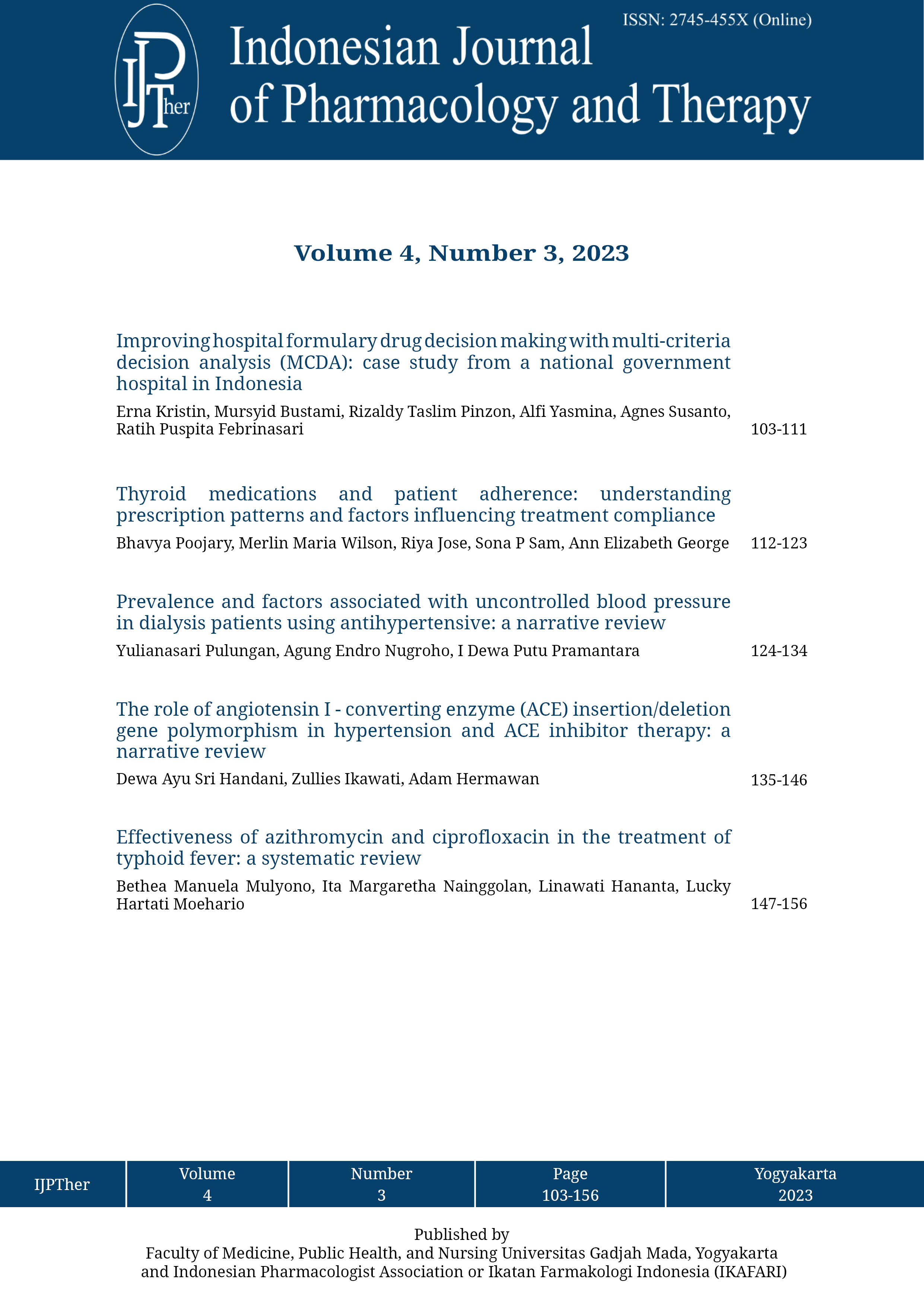Thyroid medications and patient adherence: understanding prescription patterns and factors influencing treatment compliance
Abstract
Thyroid problems are common in India affecting around 42 million people. Early diagnosis and therapy play an important role in managing this endocrine disorder. Hypothyroidism and hyperthyroidism are the most common thyroid disorders and are treated with thyroid hormone replacement therapy and antithyroid drugs. However, medication adherence, side effects, and misunderstanding of the importance of medication lead to inconsistent intake. This study aimed to evaluate the pattern of prescribing and adherence to thyroid medication. This cross-sectional study was conducted over 6 months in a tertiary care hospital, involving 188 patients with thyroid disorders. Data was collected using a validated form and medication adherence rationing scale. The collected data, including MARS scores, were entered into Microsoft Excel and analyzed using IBM SPSS Version 25. Quantitative data were analyzed using the mean and standard deviation, while categorical data were summarized using frequencies and percentages. The Chi-square test was used to evaluate associations, with a significance level of p < 0.05. In our study, 163 participants diagnosed with hypothyroidism exhibited a notable adherence rate of 89.57%. The 25 hyperthyroid patients showed strong adherence to the recommended drugs, with those provided methimazole having the highest adherence rate (52.0%). No statistically significant connections were found when examining the variables affecting drug adherence. Levothyroxine and methimazole were the preferred medications for managing hypothyroidism and hyperthyroidism, respectively. A high adherence rate among patients indicates heightened awareness and understanding of their condition, as well as consistent adherence to the medication schedule. These findings emphasize the importance of early diagnosis, appropriate prescription patterns, and patient adherence in effectively managing thyroid disorders.
References
Nagarkar R, Roy S, Akheel M, Palwe V, Kulkarni N, Pandit P. Incidence of thyroid disorders in India: an institutional retrospective analysis. Int J Dent Med Specialty 2015; 2(2):19-23.
https://doi.org/10.5958/2394-4196.2015.00012.6
Singh A, Purani C, Mandal A, Mehariya KM, Das RR. Prevalence of thyroid disorders in children at a tertiary care hospital in Western India. J Clin Diagn Res 2016; 10(2):SC01-4.
https://doi.org/10.7860/JCDR/2016/16315.7189
Bose A, Sharma N, Hemvani N, Chitnis DS. A hospital based prevalence study on thyroid disorders in Malwa region of Central India. Int J Curr Microbiol App Sci 2015; 4(6):604-11.
Unnikrishnan AG, Menon UV. Thyroid disorders in India: an epidemiological perspective. Indian J Endocrinol Metab 2011; 15(Suppl 2):S78-81.
https://doi.org/10.4103/22308210.83329
Jonklaas J, Bianco AC, Bauer AJ, Burman KD, Cappola AR, Celi FS, et al. Guidelines for the treatment of hypothyroidism: prepared by the american thyroid association task force on thyroid hormone replacement. Thyroid 2014; 24(12):1670-751.
https://doi.org/10.1089/thy.2014.0028
Kravets I. Hyperthyroidism: Diagnosis and treatment. Am Fam Physician 2016; 93(5):363-70.
Simpson SH, Eurich DT, Majumdar SR, Padwal RS, Tsuyuki RT, Varney J, et al. A meta-analysis of the association between adherence to drug therapy and mortality. BMJ 2006; 333(7557):15.
https://doi.org/10.1136/bmj.38875.675486.55
Basım P, Argun D, Ozdenkaya Y. Self‐reported medication adherence in differentiated thyroid cancer survivors: role of illness perception and medication beliefs. Head Neck 2021; 43(2):428-37.
https://doi.org/10.1002/hed.26488
Kumar R, Shaukat F. Adherence to levothyroxine tablet in patients with hypothyroidism. Cureus 2019; 11(5):e4624.
https://doi.org/10.7759/cureus.4624
Shakya Shrestha S, Risal K, Shrestha R, Bhatta RD. Medication adherence to levothyroxine therapy among hypothyroid patients and their clinical outcomes with special reference to thyroid function parameters. Kathmandu Univ Med J 2018; 62(2):129-37.
John M. Burden of thyroid diseases in India, need for aggressive diagnosis. Medicine update 2008; 18:334-41.
Leso V, Vetrani I, De Cicco L, Cardelia A, Fontana L, Buonocore G, et al. The impact of thyroid diseases on the working life of patients: a systematic review. Int J Environ Res Public Health 2020; 17(12):4295.
https://doi.org/10.3390/ijerph17124295
Patel H, Pandya A, Arya V, Patel S, Malhotra S. A study to evaluate prescription pattern, adherence to medication and quality of life in Indian patients suffering from thyroid disorders. EC Pharmacol Toxicol 2020; 57-67
Hollowell JG, Staehling NW, Flanders WD, Hannon WH, Gunter EW, Spencer CA, et al. Serum TSH, T4, and thyroid antibodies in the United States population (1988 to 1994): National Health and Nutrition Examination Survey (NHANES III). J Clin Endocr 2002; 87(2):489-99.
https://doi.org/10.1210/jcem.87.2.8182
Mulder JE. Thyroid disease in women. Med Clin North Am 1998; 82(1):103-25.
https://doi.org/10.1016/s0025-7125(05)70596-4
Cappelli C, Castello R, Marini F, Paoletta A, Marchetti M, Saullo M, et al. Adherence to levothyroxine treatment among patients with hypothyroidism: a Northeastern Italian Survey. Front Endocrinol (Lausanne) 2018; 9:699.
https://doi.org/10.3389/fendo.2018.00699
Messina M, Milani P, Gentile L, Monaco A, Brossa C, Porta M, et al. Initial treatment of thyrotoxic Graves' disease with methimazole: a randomized trial comparing different dosages. J Endocrinol Invest 1987; 10(3):291-5.



